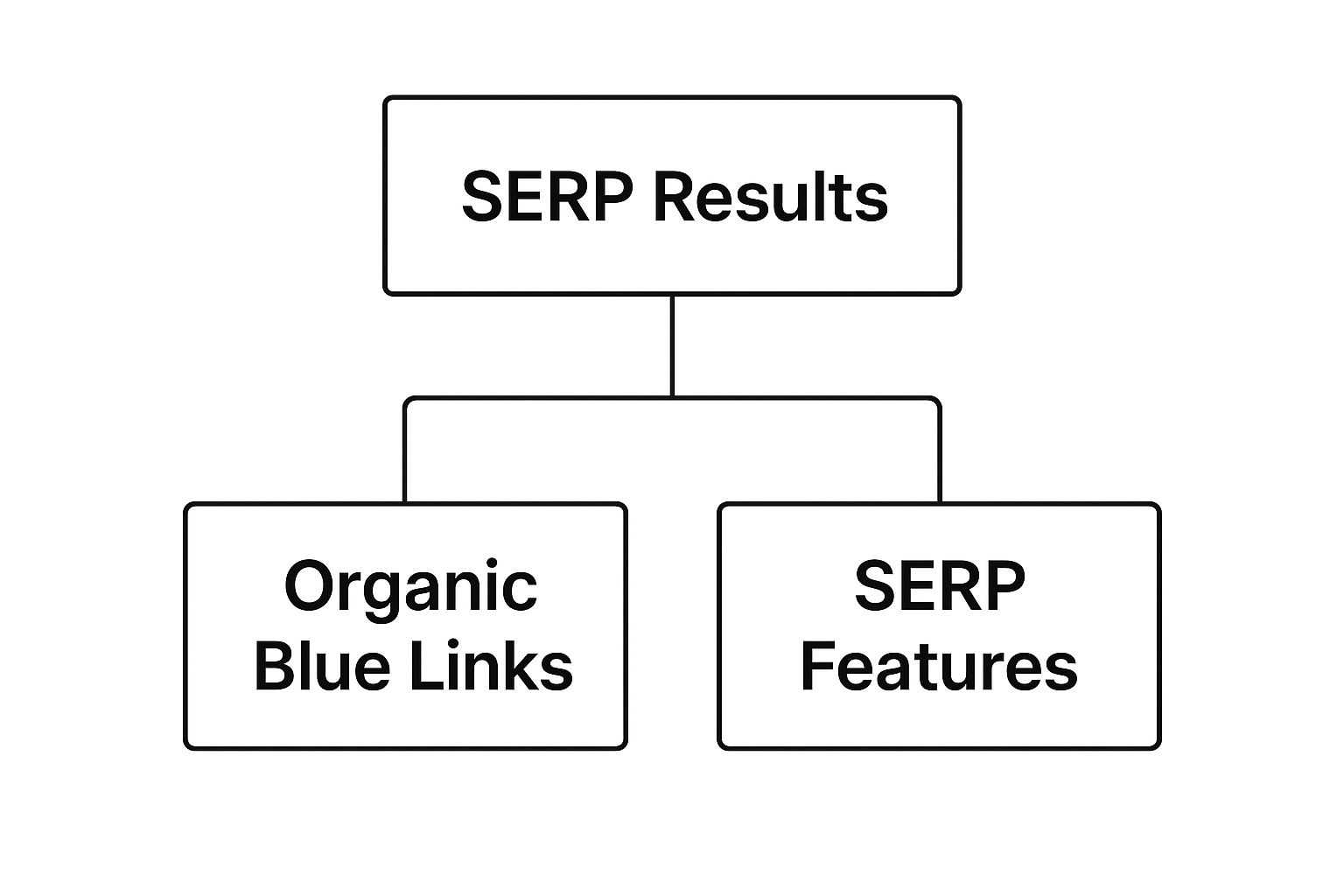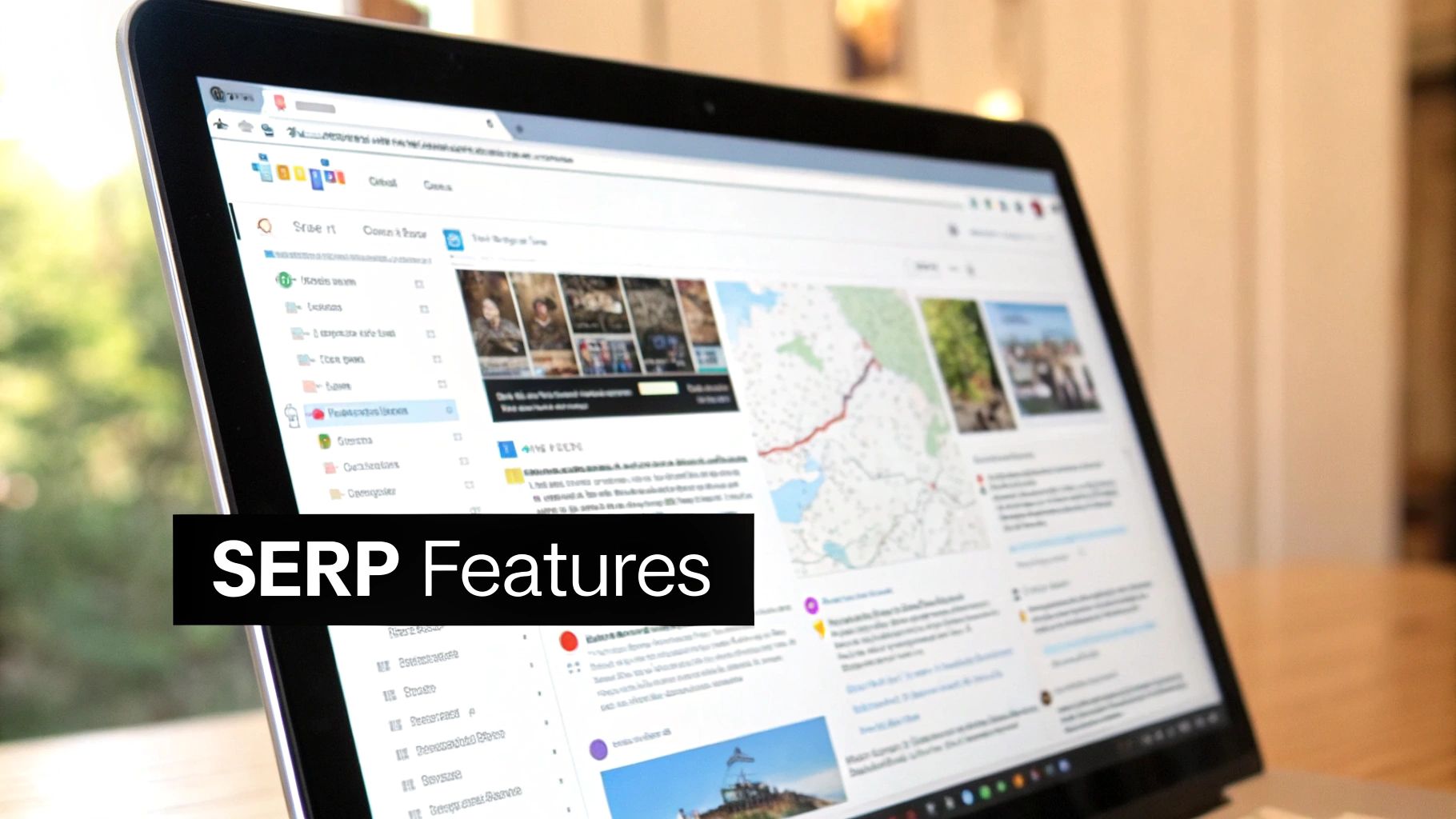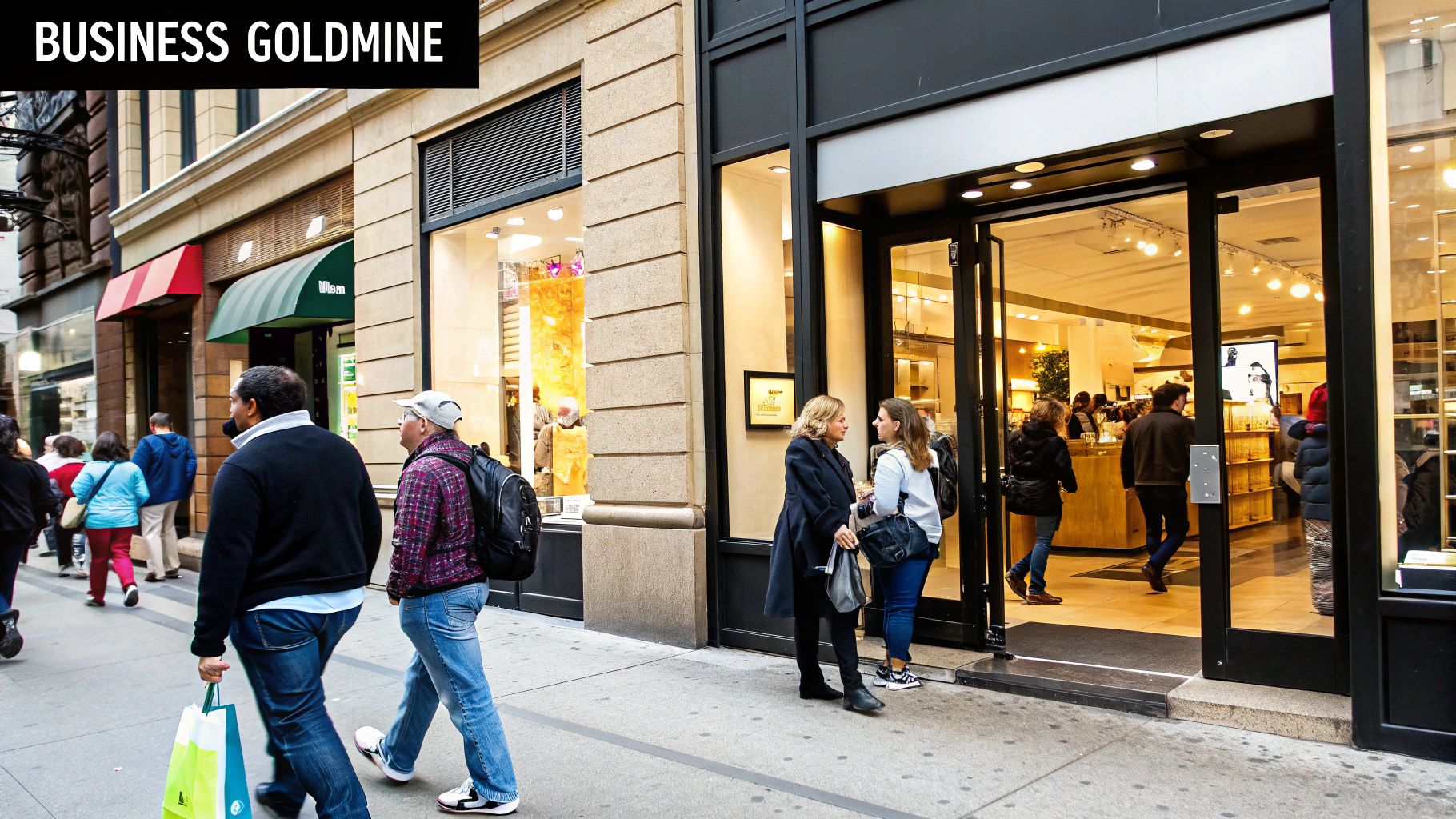
What Is a SERP Feature and How Do They Work
Share
Remember the early days of Google? You'd type something in and get a clean, predictable list of ten blue links. It was like a digital library card catalog—simple, functional, but pretty basic.
Fast forward to today, and that simple list has morphed into a dynamic, interactive dashboard. This evolution is at the heart of modern SEO.
From Blue Links to a Dynamic Dashboard
The Search Engine Results Page (SERP) isn't just a list of directions to other websites anymore; for many searchers, it is the destination. The driving force behind this massive shift? SERP features.
What Defines a SERP Feature
Put simply, a SERP feature is any result on a Google search page that is not a traditional organic link. These are special elements—think answer boxes, image carousels, or local map packs—that Google uses to give you information directly on the results page.
The whole point is to answer your question or solve your problem as quickly as possible, often without you ever needing to click through to a website. They're Google's primary tools for making search faster and more useful.
This infographic breaks down the two distinct categories you'll find on a modern results page.

As you can see, the game has changed. SEO is no longer just about those classic "blue links." It’s about competing for visibility across this entire, diverse landscape.
To help clarify, this table breaks down the core concepts.
SERP Features at a Glance
| Concept | Description | Impact on SEO |
|---|---|---|
| Traditional Organic Results | The classic "10 blue links" format, showing a page title, URL, and a short description. | This is the foundation of SEO, but its dominance has shrunk significantly. |
| SERP Features | Any non-traditional result, like Featured Snippets, Local Packs, or Video Carousels. | These features often appear at the top, pushing organic results down and changing how users interact with the page. |
| Zero-Click Searches | A search where the user gets their answer directly from the SERP and doesn't click any link. | The rise of SERP features is the main driver of zero-click searches, making visibility within features crucial. |
This shift means that simply ranking well organically isn't enough. You have to think about how and where you can show up within these features.
The New Normal for Search Results
These features aren't a novelty; they are the new standard. In fact, a staggering 98.47% of searches now include at least one SERP feature. Seeing a page with only blue links has become incredibly rare.
What this means for your business is that for almost every search query, you aren't just competing with other websites. You're competing with Google's own answer boxes, map packs, and shopping results. You can dig into the prevalence of SERP features with data from Semrush to see just how widespread this is.
The modern SERP is an answer engine, not just a directory. Ranking #1 organically is no longer the whole story; visibility within these features is now a critical measure of success.
This fundamental change requires a new approach. For businesses in a competitive space like restaurant equipment, you can't afford to ignore these prominent, attention-grabbing elements. Winning in search today means building a strategy that actively targets them.
The Most Common Types of SERP Features
So, you know what a SERP feature is. The next logical question is, "How many of them are there?" The honest answer is that Google is always testing new layouts, but thankfully, most of them fall into a few key categories.
Thinking about them in groups makes the whole landscape a lot less intimidating. I generally break them down into three buckets: features that supercharge organic results (Rich Results), those that give you answers right on the page (Knowledge Graph Features), and the all-important ones for local businesses (Local Features). Each one shows up based on what the searcher is actually looking for.

Just look at this single search for "best restaurant supply store near me." You’ve got a Local Pack, organic results with bright orange review stars, and a "People Also Ask" box all fighting for your click. It's a crowded space.
Rich Results: Making Your Listings Pop
Think of Rich Results as visual upgrades for the classic blue links. They tack on extra, helpful information that makes a standard search result more enticing and much more likely to get clicked.
These little enhancements are usually powered by structured data you add to your website. They don't spill all the beans on the results page; instead, they give searchers a tempting preview that makes them want to learn more.
A few you've definitely seen are:
- Review Snippets: Those little star ratings under a page title. They provide immediate social proof and build trust before anyone even visits your page for a commercial oven.
- FAQ Snippets: A neat dropdown list of common questions and answers that sits right below your main link. This helps you answer user questions upfront and take up a ton more screen space.
- Sitelinks: When someone searches for your brand, Google often shows an expanded list of key pages from your site. This helps them jump straight to your "Contact" or "Products" page. A great meta description makes these links work even harder, which you can learn about in our guide on how to write meta descriptions that pull in clicks.
Knowledge Graph Features: The Instant Answer Crew
This next group is all about speed and convenience. These features aim to answer a searcher's question directly on the results page, pulling information from a variety of sources Google deems trustworthy. They’re a big reason why "zero-click searches" are on the rise.
Featured Snippets are the king of this category. Often called "position zero," it's that prominent box at the very top of the page that gives a direct, concise answer to a question, citing the source website below.
Other common Knowledge Graph features include:
- Knowledge Panels: The big informational boxes that show up on the right-hand side of the screen for searches about specific things, like your company or a well-known brand.
- People Also Ask (PAA): That accordion-style box of related questions. Clicking one expands it to show a quick answer, often sending users down a rabbit hole of related topics.
- Image Packs & Video Carousels: These are the horizontal rows of images or videos you see for visual-heavy searches, like "how to clean a commercial deep fryer."
Local SERP Features: Driving Foot Traffic
For any business with a physical address, Local SERP features are gold. They show up when Google detects local intent in a search, like queries that include "near me" or a specific city.
The most valuable of these is, without a doubt, the Local Pack. This is the map with 3 business listings right below it. Each listing is packed with essential info: business name, address, phone number, and those all-important customer ratings. For a restaurant equipment supplier, getting into the Local Pack for a search like "commercial refrigeration repair" can lead directly to phone calls and customers walking through your door. It's a game-changer.
To help put it all together, here’s a quick table breaking down which features tend to show up for different types of searches.
Common SERP Features and Their Triggers
Understanding what kind of search triggers a specific feature is the first step in trying to win that placement for yourself.
| Feature Category | Examples | Common Search Query Trigger |
|---|---|---|
| Rich Results | Review Stars, FAQ Snippets, Sitelinks | Product searches ("commercial ice machine"), branded searches ("Your Company Name"), informational queries with common questions. |
| Knowledge Graph | Featured Snippets, PAA Boxes, Knowledge Panels | Question-based searches ("what is the best commercial mixer?"), searches for specific entities ("Vollrath company profile"). |
| Local Features | Local Pack, Local Finder, Map Results | Geographically-specific searches ("restaurant equipment Chicago"), implicit local queries ("walk-in cooler service near me"). |
As you can see, the searcher's intent is the driving force behind everything. Your job is to create content and structure your site in a way that aligns with that intent to capture these valuable spots.
How SERP Features Reshape User Behavior
SERP features aren't just cosmetic upgrades to the search results page. They fundamentally change how people find what they're looking for. Google designed them to deliver answers as fast as humanly possible, often without you ever needing to leave the search page.
This instant access has rewired our brains. We've been trained to expect immediate answers. Instead of methodically scanning a list of ten blue links, our eyes instinctively dart to the most helpful-looking element on the page—a map, a neat answer box, or a row of videos.
Of course, this completely changes the game for click-through rates and what we once considered a "normal" user journey.
The Rise of the Zero-Click Search
One of the biggest shifts we've seen is the explosion of the "zero-click search." This is exactly what it sounds like: a user types in a question, gets the answer they need right there on the results page, and never actually clicks through to a website.
Features like Featured Snippets and the "People Also Ask" section are the main culprits here. They serve up quick, digestible answers, meaning the user's search ends on Google, not on your site. For instance, if someone searches for "how to reset a commercial fryer," a Featured Snippet might pop up with a perfect step-by-step list. Problem solved, no click needed.
This is precisely why the old SEO mantra of "ranking number one" doesn't tell the whole story anymore. If a big, helpful Featured Snippet sits on top of your #1 ranking and answers the user's question, that top spot you worked so hard for might get a lot fewer clicks than you think.
In today's world, visibility inside a SERP feature can be far more valuable than a traditional top ranking.
Dominating Above the Fold with Position Zero
Not only are SERP features common, but they also hog the most valuable real estate on the page: the space "above the fold." The holy grail is the Featured Snippet, which is so important it earned the nickname "position zero" because it sits above the first organic result.
First appearing back in 2014, these snippets are attention magnets. For some searches, they can grab up to 35% of all clicks, essentially siphoning them away from the classic blue links below. Getting into this spot is tough, but the authority it gives your brand is immense. You can discover more insights about SERP feature impact on Backlinko to see just how powerful they are.
This new dynamic has completely changed what users are looking for:
- From Lists to Answers: People aren't just hunting for the best link anymore; they're hunting for the fastest answer.
- Trust in Features: When Google puts your content in a special box, users see it as an endorsement. It's an instant credibility booster.
- Visual Engagement: For visual queries, Image Packs and Video Carousels are impossible to ignore, pulling clicks away from plain text results.
Ultimately, SERP features have turned the results page into a battleground where attention is the ultimate prize. Understanding how users now behave is the first crucial step in building an SEO strategy that doesn't just earn rankings, but wins real, meaningful traffic.
Why SERP Features Are a Goldmine for Your Business

For anyone in a competitive field like restaurant equipment, ignoring SERP features is like leaving cash on the table. They’re not just cosmetic additions to the search results page; they are powerful tools that connect you directly with customers who are ready to buy—often letting you skip right past the competition.
Think about it. We’re not talking about some fuzzy concept like "brand awareness." SERP features drive real, measurable actions that directly impact your bottom line. Earning a spot in one of these features is a shortcut to building trust and pulling in high-quality traffic from people who are actively looking for what you sell.
These elements change the entire search experience. A potential customer isn't just seeing a blue link anymore. They're seeing your star rating, your business pinned on a map, or a picture of the exact commercial oven they need. It’s a completely different ballgame.
Drive Immediate Local Action
The most obvious win here, especially for businesses with a physical location, is the Local Pack. When a local chef searches for "commercial kitchen supplies near me," showing up in that map block with three listings is pure gold. It's a direct invitation for a phone call or a visit to your showroom.
The Local Pack puts your most important details right where everyone can see them:
- Your exact location on an interactive map.
- Your phone number, complete with a handy "click-to-call" button on mobile.
- Your customer rating, giving you instant social proof.
Making it into the Local Pack means you're not just another option; you're one of the top three trusted choices Google is personally recommending. It's the digital equivalent of having the best storefront on the busiest street in town.
The impact here is huge, influencing both how many people find you and what they think of your brand. Ranking in a feature can give you 2-3 times more visibility than a standard organic link, even if no one clicks on it.
This is because SERP features often take up 60-80% of the visible screen on many search results, making them the first and most dominant thing people see. You can dig deeper into how SERP features are reshaping digital marketing on Exploding Topics to see the full picture.
Build Trust and Boost Clicks
Beyond local searches, SERP features build your credibility before a user even lands on your website. Take Review Snippets—those little gold stars that pop up under your link. They immediately signal quality and trustworthiness at a glance.
Similarly, an Image Pack can show off your equipment before anyone clicks. A search for a "six-burner gas range" might bring up a carousel of product photos. If your picture is in that lineup, you’ve grabbed a customer's attention with a compelling visual before they’ve read a single word of your description.
These features don't just get you more eyeballs. They pre-qualify your traffic, bringing in users who are much further along in their buying journey and far more likely to convert.
How to Optimize Content for SERP Features

Alright, knowing what SERP features are is one thing. Actually winning them is a different game entirely. So, let’s shift from theory to action. Landing these valuable spots on Google isn't about luck; it's about a smart, deliberate strategy that lines up your content with exactly what search engines are looking for.
Think of it this way: your job is to make it incredibly easy for Google to understand your content and see it as the absolute best answer for a searcher's question. This means structuring your pages in specific ways and sending clear signals to the search engine crawlers about what’s on the page.
It's a mix of great content creation and some basic technical SEO. Once you get the hang of a few key techniques, your chances of getting featured will go way up.
Structure Your Content for Featured Snippets
The Featured Snippet—often called "position zero"—is the holy grail of SERP features. To have a shot at it, you have to think less like a writer and more like an answer engine. Your content needs to provide clear, immediate answers to common questions.
First, pinpoint a question your customers are actually asking, like "what is the best commercial convection oven?" Then, answer that question directly and right away in your content. Don't bury the lead.
Here's a pro tip: use the question as a heading (like an H2 or H3 tag) and then immediately follow it with a direct answer in the very next paragraph. Keep that paragraph tight—somewhere between 40 and 60 words is the sweet spot for a snippet.
Google also loves to pull answers that are formatted for easy reading. Try using:
- Numbered lists for any kind of process or step-by-step guide (e.g., "how to clean a grease trap").
- Bulleted lists for roundups or feature highlights ("top features of a commercial ice machine").
- Tables for when you’re comparing products head-to-head ("Hobart vs. KitchenAid mixers").
Use Schema Markup to Earn Rich Results
Ever wonder how some search results get those shiny review stars or helpful FAQ dropdowns? That’s the magic of Rich Results, and the way you get them is by speaking Google's language. This is where structured data, also known as Schema markup, comes in. It's basically a special vocabulary you add to your website's code to tell search engines exactly what your content is about.
For instance, you could add Recipe schema to a blog post about making pizza dough. That code tells Google the cook time, ingredients, and calorie count, making your page eligible for a fancy recipe card in the search results. If you want to go deeper on this, there are some great advanced SEO copywriting tips, including optimizing for featured snippets that can help.
For a restaurant equipment supplier, the most useful types of schema are:
-
Productschema to show things like price, availability, and customer ratings. -
Reviewschema to pull in those all-important star ratings right into the SERP. -
FAQPageschema to create those interactive dropdowns for your frequently asked questions.
Adding schema markup is a cornerstone of any solid on-page SEO effort. It directly helps Google understand and feature your content in more interesting ways. To get the full picture, check out our guide on what is on-page optimization.
Target People Also Ask with a Q&A Format
That "People Also Ask" (PAA) box is a goldmine for traffic. To show up here, you need to structure parts of your content in a simple question-and-answer format.
Do a little research to find common follow-up questions related to your main topic. Then, weave those into your article, answering each one clearly and concisely.
The best way to do this is to make each question a subheading, followed by a direct, straightforward answer. This structure perfectly mimics the PAA format, making it a no-brainer for Google to grab your content and plug it right into the box.
Start Winning with a SERP Feature Strategy
If you've made it this far, you know that modern SEO isn't just a simple race to the top of the organic results anymore. It’s a full-blown competition for visibility across the entire search page. Getting a handle on what a SERP feature is—whether it's a Featured Snippet, a Local Pack, or a PAA box—is your first real step toward dominating this new territory.
These aren't just fancy bells and whistles; they fundamentally change how people find information and make decisions. They can build instant trust and often pull in more high-quality traffic than a traditional number one ranking ever could. The big takeaway here is that your strategy needs to evolve. Stop just "creating content" and start structuring it to answer specific questions and satisfy search intent head-on. This shift in mindset is what turns SERP features from a threat into your single biggest opportunity.
The real goal of SEO today is to become the most convenient and authoritative answer for a user's query, wherever on the results page that answer may appear.
So, what’s next? It's time to get your hands dirty. Go analyze the SERPs for the keywords that matter most to your business. See which features pop up and start thinking about how you can create content designed specifically to win those spots. A great starting point is learning how to track keyword rankings so you can get a clear picture of where you stand today.
In the end, the brands that win will be the ones who adapt.
Common Questions About SERP Features
Once you start wrapping your head around what SERP features are, a few practical questions always seem to pop up. Let's dig into some of the most common ones to clear up how these things actually work out in the real world.
One of the first things people want to know is if they can just open their wallet to get a top spot.
Can You Pay for SERP Features?
For the most valuable organic spots, the answer is a hard no. You can't just pay Google to stick your content in a Featured Snippet, a People Also Ask box, or the organic listings inside a Local Pack. These are earned, plain and simple, through great content and smart SEO.
Of course, this doesn't apply to everything. Features that are clearly marked as "Sponsored," like Google Ads and Shopping results, are entirely pay-to-play. But the organic features? Those are all about merit.
How Long It Takes to Rank
This is where things get interesting. Unlike the slow and steady climb of traditional organic rankings, which can take months, nabbing a SERP feature can sometimes happen surprisingly fast. If you create a perfectly structured piece of content that nails the answer to a user's question, you could find yourself owning a Featured Snippet in a relatively short time.
The timeline really depends on the feature you're targeting, your website's overall authority, and how tough the competition is. Some features might pop up in a few weeks; others can be a much longer game.
Mobile vs. Desktop Differences
Do SERP features look the same everywhere? Nope. While most features exist on both desktop and mobile, their appearance and a user's reliance on them can change dramatically. Mobile search results are all about getting quick, direct answers on a small screen.
- Local Packs are king on mobile, often showing up with handy click-to-call buttons.
- Video Carousels and Image Packs are perfect for capturing the attention of someone scrolling on their phone.
- AI Overviews deliver those quick-hit summaries that are ideal for users who don't have time to read a full article.
The bottom line is that while the features are present on both, your strategy has to be mobile-first to win. If you're looking to get into the weeds of more advanced AI-powered strategies, this guide on Agentic AI SEO Content Optimisation FAQs is a great resource.